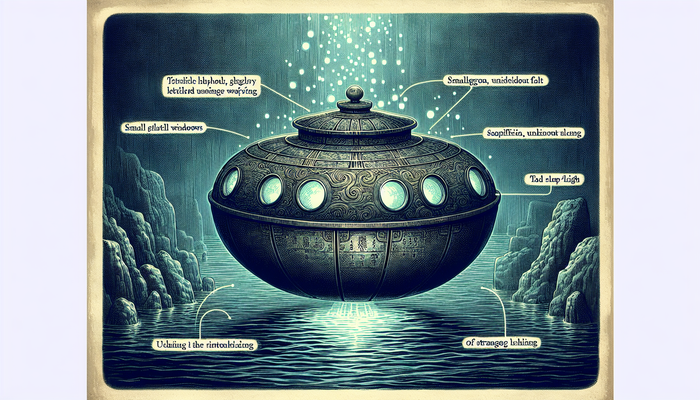Exploring Moon Anomalies

By Elaine Westfield, Ufologist
Look up at the night sky and there it is – the Moon, our cosmic companion that has captivated humanity since we first gazed skyward. It hangs there so familiarly that we almost take it for granted. Yet beneath that serene exterior lies a celestial body far stranger and more complex than most people realize. Despite decades of intense study and multiple missions, our closest neighbor continues to challenge scientific understanding with its peculiar characteristics and unexplained phenomena.
These aren't just the fanciful imaginings of conspiracy theorists. Many Moon anomalies have been documented by NASA, measured by scientific instruments, and verified through multiple missions. As we stand on the cusp of a new era of lunar exploration – with NASA's Artemis program, China's Chang'e missions, and various commercial ventures setting their sights on the Moon – understanding these anomalies has never been more important.
The Invisible Sculptor: Unpacking the Mystery of Lunar Mascons
When the first spacecraft began orbiting the Moon in the 1960s, something strange happened. Both Soviet and American missions noticed their orbits changing unexpectedly. The culprit wasn't equipment failure or human error, but rather the Moon itself.
"The way the Moon's gravity behaved was completely unexpected," explains Dr. Maria Zuber, principal investigator of NASA's GRAIL mission. "Spacecraft would accelerate as they passed over certain regions, particularly the dark areas we call mare."
These gravitational anomalies, dubbed "mascons" (mass concentrations), caused orbital deviations up to 100 times greater than predicted. For Apollo mission planners, this presented a serious challenge – how do you land precisely when the Moon's gravity keeps pushing you off course?
In 2011, NASA launched the twin GRAIL spacecraft specifically to map these gravitational quirks in unprecedented detail. The resulting gravity maps revealed something counterintuitive: while mountains have higher gravity than craters (as you'd expect), some of the flat, dark lava plains have even stronger gravitational pulls than the mountains.
The science behind mascons is fascinating. When massive asteroids struck the Moon billions of years ago, they didn't just create craters – they punched so deep that they excavated denser material from the Moon's mantle. Later, these depressions filled with heavy basaltic lava, creating areas of concentrated mass. It's like a cosmic bruise that never fully healed, with the dense material still weighing down the basin floor by over half a mile in places.
"It's easier to understand why the Moon shouldn't have mascons than why it does," notes Zuber. Their very existence tells us something important about the Moon's interior – it must be rigid and cool enough to support these mass imbalances for billions of years without reaching equilibrium.
The Giant Scar and its Secret Mass: The South Pole-Aitken Basin Anomaly
Speaking of impacts, let's talk about the largest one we know of in our solar system. The South Pole-Aitken (SPA) basin spans 2,500 kilometers – roughly the distance from Washington D.C. to Houston – covering much of the Moon's far side. But what's underneath is even more impressive.
In 2019, researchers analyzing GRAIL data discovered something astonishing: a massive, dense object buried hundreds of miles beneath the basin's surface. "Imagine taking a pile of metal five times larger than the Big Island of Hawaii and burying it underground. That's roughly how much unexpected mass we detected," said Peter B. James, the study's lead author.
This hidden behemoth weighs around 2.18 × 10^18 kilograms – a number so large it's almost meaningless without comparison. Two competing theories explain its presence. It might be the dispersed core of the asteroid that created the basin, its metal spreading through the lunar mantle rather than sinking to the core. Alternatively, it could be a concentration of dense oxides that formed during the final cooling stages of a primordial lunar magma ocean.
Whatever its origin, this mass anomaly's continued existence provides a unique glimpse into the Moon's internal dynamics. The fact that this enormous weight hasn't sunk into the Moon's core over billions of years suggests the lower mantle has remained remarkably rigid and cool throughout lunar history.
The South Pole-Aitken basin serves as what scientists call a "natural laboratory" – a place where we can study the aftermath of catastrophic impacts similar to those that shaped all rocky planets and moons in our solar system's early days.
A Lopsided World: Anomalies in Composition and Structure
Have you ever noticed that the Moon always shows us the same face? This isn't coincidental – it's tidally locked to Earth. But beyond this orbital oddity, the Moon displays a remarkable asymmetry in its very nature.
The near side (facing Earth) and far side are dramatically different. The near side sits lower in elevation, has a thinner crust, is covered in dark lava plains, and contains unusually high concentrations of rare elements like titanium. The far side is higher, thicker-crusted, lacks extensive lava plains, and has a different chemical composition.
This lopsidedness presents a genuine scientific puzzle. Rocks brought back by Apollo astronauts contained surprisingly high titanium concentrations, which later missions confirmed were primarily located on the near side.
The most compelling explanation for this asymmetry takes us back to the Moon's fiery birth. After forming from Earth-impact debris, the young Moon was likely covered by a global magma ocean. As this ocean cooled, dense minerals including ilmenite (containing titanium and iron) crystallized.
"Since these heavy minerals are denser than the mantle underneath, it creates a gravitational instability," explains Weigang Liang of the University of Arizona. In a process scientists call "overturn," this dense layer should have sunk deeper into the lunar interior.
Computer models suggest something remarkable happened. The dense titanium-rich layer first migrated to the near side, possibly triggered by a giant impact on the far side. Then it sank in a network of sheet-like slabs, cascading like waterfalls into the lunar interior. But not all of it sank – some remained as a geometric pattern of titanium-rich material beneath the crust.
This theoretical model gained powerful support when GRAIL discovered a network of linear gravity anomalies that perfectly match where these remnants should be. "Our analyses show that the models and data are telling one remarkably consistent story," notes Liang. The Moon quite literally turned itself inside out, and we can still see the evidence billions of years later.
Painted on the Surface? The Enigma of Lunar Swirls
Some of the most visually striking anomalies are visible even with a decent amateur telescope. Lunar swirls are sinuous, light-colored patterns that appear almost painted across darker regions of the Moon. Reiner Gamma, the most famous, stretches for dozens of kilometers across Oceanus Procellarum.
What makes these swirls particularly puzzling is their association with magnetic anomalies. The Moon lacks a global magnetic field today, yet the rocks within these swirls are magnetized. These localized magnetic fields act as shields, deflecting the solar wind particles that normally darken the lunar surface over time. Areas protected by the magnetic fields stay lighter, creating the distinctive swirl patterns.
But where did these magnetic fields come from? While meteorite impacts might explain some swirls, many show no evidence of impact. A newer theory suggests the magnetism originates from subsurface magma that cooled slowly within a localized magnetic field.
"Our work connects the dots between the geophysical evidence for the interior structure of the moon and computer models of its evolution," explains Liang. Experiments show that ilmenite, abundant in lunar rocks, can become magnetized under certain conditions – especially smaller grains with more surface area. Titanium-rich underground magma could have created these magnetic anomalies as it cooled, leaving a permanent imprint on the lunar surface.
NASA is taking these swirls seriously enough to send a dedicated mission. In 2025, the Lunar Vertex rover will visit Reiner Gamma to study its magnetic properties up close – information critical not just for understanding the Moon's history but also for planning future human habitats that must contend with lunar dust.
Flickers in the Darkness: The Lingering Puzzle of Transient Lunar Phenomena
For centuries, observers have reported fleeting changes on the lunar surface – bright flashes, colorful glows, mysterious hazes, and temporary darkening. These Transient Lunar Phenomena (TLP) range from the credible to the dubious, yet their persistence across time and cultures makes them difficult to dismiss entirely.
One of the earliest documented cases comes from 1178, when Canterbury monks reported what appeared to be a massive explosion on the Moon – possibly the impact that created the crater we now call Giordano Bruno. In 1866, astronomer Royal J.F.J. Schmidt noticed that the crater Linné, which previous observers had described as deep and distinct, suddenly appeared as a mere white spot. Other reports include reddish clouds over craters, mists obscuring familiar features, and points of light lasting just minutes.
Many TLP reports undoubtedly stem from Earth's atmospheric distortions, optical illusions from changing lighting conditions, or simple observer error. However, some observations by experienced astronomers using quality equipment resist easy explanation.
The crater Aristarchus is a particular hotspot for these phenomena. Even Apollo 11 astronauts were asked to observe it after Earth-based telescopes spotted a reddish glow. Astronaut Michael Collins confirmed seeing an unusual area of luminescence, eliminating Earth's atmosphere as the cause.
"Current knowledge of the moon's magnetic properties is very limited," notes planetary geologist Ottaviano Rüsch. Some TLP might be explained by outgassing from beneath the surface, especially since recent missions have shown the Moon isn't as geologically dead as once thought. Electrostatic charging of lunar dust during solar storms could also create visible phenomena, particularly near the poles.
While definitive proof remains elusive, these historical anomalies add to the Moon's mystique and highlight how much we still have to learn about our celestial companion.
Secrets in the Archives? The Mystery of "Classified" Lunar Images
A more controversial aspect of lunar anomalies involves allegedly "classified" photographs from various Moon missions. Several researchers have noted missing sequential frames in publicly released archives from Ranger, Lunar Orbiter, and Apollo missions.
When questioned about these gaps, some archive custodians reportedly stated that only "unclassified images" were made available. This naturally raises the question: what could possibly need classification on an airless, seemingly uninhabited world?
The most reasonable explanation involves military sensitivity. Missions like Clementine, jointly conducted by NASA and the Ballistic Missile Defense Organization, used technologies with national security implications. The resolution and capabilities of these imaging systems could reveal classified information about surveillance technology.
However, this explanation hasn't satisfied everyone. The missing frames, combined with reports of radio blackouts during key Apollo mission moments, have fueled speculation about what might have been observed but not shared with the public.
While it's important to approach such claims skeptically, the mystery of these missing images represents an interesting tension between public curiosity and official narratives about lunar exploration. Was anything truly extraordinary captured in these images? Or is their absence simply a bureaucratic artifact of Cold War secrecy practices?
Beyond Conventional Science: Exploring Unconventional Moon Theories
When standard explanations seem insufficient to some observers, unconventional theories emerge. The most persistent of these suggests the Moon isn't natural at all – it's artificial, either partially or entirely.
The Hollow Moon theory gained prominence after two Soviet scientists, Mikhail Vasin and Alexander Sherbakov, published a paper in 1970 suggesting the Moon might be an artificial satellite constructed by an ancient intelligence. They proposed its shell could be made of durable materials like titanium, potentially housing interior chambers or even machinery.
Proponents point to several anomalies as supporting evidence:
- First, the Moon's density is unusually low – about 60% of Earth's.
- Second, when Apollo mission controllers deliberately crashed lunar modules onto the surface, seismometers recorded vibrations lasting 30-90 minutes, with Apollo 13's lasting over 3 hours. On Earth, similar impacts would dissipate in minutes. "The moon rang like a bell," astronauts reported, leading some to suggest a hollow or non-solid structure.
- Other cited "evidence" includes observations that lunar craters reach similar depths regardless of diameter, as if hitting a rigid boundary; the Moon's nearly perfect circular orbit and tidal locking; and ancient myths from multiple cultures describing a time before the Moon existed.
While mainstream science readily explains these observations through conventional lunar geology and orbital mechanics, the Hollow Moon theory persists among those who find standard explanations unsatisfying.
The search for potential technosignatures on the Moon exemplifies how even speculative theories can influence scientific approaches. When Paul Davies and Robert Wagner proposed searching lunar reconnaissance photos for evidence of extraterrestrial artifacts in 2011, they were applying serious scientific methodology to test claims that most scientists would consider highly improbable.
The Dawn of Automated Discovery: AI and the Future of Anomaly Hunting
The modern era of lunar exploration has generated an overwhelming volume of data. The Lunar Reconnaissance Orbiter (LRO) alone has collected petabytes of imagery since 2009 – far more than humans could ever manually analyze.
Enter artificial intelligence. Researchers have developed AI systems specifically designed to identify anomalies in lunar imagery without human bias. Unlike supervised learning approaches that look for specific features, these unsupervised methods flag anything that deviates significantly from "normal" lunar terrain.
"Our method is an unsupervised and therefore unbiased method," explains Daniel Angerhausen, an astrophysicist working on lunar anomaly detection. "It's really a very very agnostic search for outliers... there's no human bias in the loop."
The AI works by training on millions of "typical" lunar images. When shown a new image, it attempts to reconstruct it from compressed information. Images containing common features are reconstructed accurately, while unusual features – potential anomalies – show higher "reconstruction loss."
This approach has already successfully identified several types of anomalies:
- Volcanic pits and skylights (collapsed sections of lava tubes) that could serve as natural shelters for future lunar habitats
- Fresh impact craters that help scientists understand meteorite bombardment rates
- Human-made structures like the Apollo landing sites, proving the system can detect "technosignatures"
- Irregular mare patches and other geological features that warrant further investigation
"If we find nothing we can kind of exclude anything that is on the order size order... or similar to the Apollo landing site," notes Angerhausen. The goal now is to scale this analysis to the entire lunar surface, which requires additional computing resources. Similar techniques could also be applied to Mars, Mercury, and other bodies, revolutionizing how we search for the unusual throughout our solar system.
Why Moon Anomalies Matter: Implications for the Future
These lunar anomalies aren't just scientific curiosities – they have profound implications for humanity's future on the Moon. Understanding the Moon's gravitational anomalies is crucial for planning spacecraft orbits and landings. Knowledge of lunar swirls and their dust behavior will be vital for designing habitats that can withstand the Moon's harsh environment.
The discovery of lava tubes and skylights through anomaly detection provides potential locations for protected lunar bases. And even the more speculative anomalies spark curiosity and drive exploration forward.
As humans prepare to return to the Moon – this time to stay – these anomalies remind us that our closest celestial neighbor still has secrets to reveal. Each discovery adds to our understanding of not just the Moon, but of planetary formation throughout our solar system.
The journey to fully understand the Moon continues with missions like Lunar Vertex, NASA's Artemis program, and the innovative application of AI to find what human eyes might miss. What new anomalies await discovery? And what will they tell us about our planet's mysterious companion?
The Moon hangs in our sky, familiar yet strange – its anomalies a testament to how much we still have to learn about the cosmos right on our doorstep.
From Bigfoot to UFOs: Hangar 1 Publishing Has You Covered!
Explore Untold Stories: Venture into the world of UFOs, cryptids, Bigfoot, and beyond. Every story is a journey into the extraordinary.
Immersive Book Technology: Experience real videos, sights, and sounds within our books. Its not just reading; its an adventure.


























